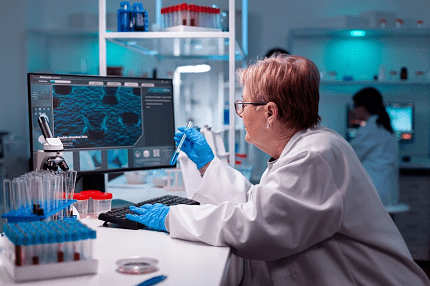Application and biotechnology in health

Application of Biotechnology in Health: Biotechnology plays a significant role in advancing healthcare and has various applications in the field of medicine. Some of the key areas where biotechnology is used in health include:
- Genetic Engineering: Biotechnology techniques are used to manipulate and modify genes, allowing scientists to develop genetically engineered organisms, including bacteria, plants, and animals. These techniques have enabled the production of therapeutic proteins, vaccines, and the study of disease mechanisms.
- Drug Development: Biotechnology plays a crucial role in the development of new drugs. Techniques such as recombinant DNA technology and high-throughput screening are used to identify potential drug targets, produce recombinant proteins for drug testing, and develop more effective medications for various diseases.
- Diagnostics: Biotechnology tools are employed in diagnostic tests to identify and monitor diseases. Techniques like polymerase chain reaction (PCR) and gene sequencing enable the detection of genetic disorders, infectious agents, and cancer biomarkers, providing valuable information for diagnosis and treatment.
- Gene Therapy: Biotechnology offers the potential for treating genetic disorders through gene therapy. This approach involves introducing normal genes into cells to correct genetic defects and restore normal cellular functions.
- Tissue Engineering: Biotechnology has revolutionized the field of tissue engineering, which involves growing functional tissues or organs in the laboratory for transplantation. This technology has the potential to overcome organ shortages and improve the success rates of transplants.
- Personalized Medicine: Biotechnology tools are employed to develop personalized medicine approaches. By analyzing an individual’s genetic makeup, researchers can identify specific genetic variations that influence drug response, allowing for tailored treatment plans.
- Vaccine Development: Biotechnology techniques are extensively used in vaccine development. Recombinant DNA technology enables the production of safer and more effective vaccines, such as those developed using viral vectors or subunit vaccines.
These are just a few examples of how biotechnology is applied in the health sector. It’s a vast field with ongoing advancements, and its applications continue to expand, contributing to improved healthcare outcomes and the development of innovative therapies.
What is Required AIIMS-SYLLABUS Biology syllabus Application and biotechnology in health
To provide a more specific answer, I’ll provide you with a general overview of the biology syllabus for the AIIMS entrance exam and how it relates to the application of biotechnology in health. Keep in mind that the AIIMS syllabus may vary slightly from year to year, so it’s essential to consult the official AIIMS website or the specific exam notification for the most up-to-date information. Here are the key topics related to biology and biotechnology:
- Cell Biology: This topic covers the structure and function of cells, including cell organelles, cell cycle, cell division, and cell signaling. Understanding cell biology is crucial for comprehending the mechanisms of biotechnology techniques used in genetic engineering and other applications.
- Genetics and Evolution: This section deals with the principles of genetics, Mendelian inheritance, chromosomal disorders, and population genetics. It provides the foundation for understanding the molecular basis of biotechnology and genetic engineering techniques.
- Biotechnology and its Applications: This topic focuses on the fundamentals of biotechnology, including recombinant DNA technology, gene cloning, DNA sequencing, and PCR. It also covers the application of biotechnology in agriculture, medicine, and environmental conservation. Understanding these concepts is essential for comprehending the applications of biotechnology in health.
- Human Physiology: This section covers the various systems of the human body, including the respiratory, circulatory, digestive, excretory, and nervous systems. It is important to have a solid understanding of human physiology to grasp the impact of biotechnological interventions on these systems and their role in health.
- Immunology: This topic covers the immune system, its components, immune response, and immune disorders. Understanding immunology is crucial for comprehending the development of vaccines, immunotherapies, and diagnostic techniques used in biotechnology.
- Biotechnology Principles and Processes: This section delves deeper into the principles and processes involved in biotechnology, such as genetic engineering, DNA fingerprinting, and gene therapy. It includes an understanding of restriction enzymes, vectors, gene expression, and molecular techniques used in biotechnology research and applications.
It is important to note that this is a general outline and may not cover every subtopic in the AIIMS syllabus. It’s advisable to refer to the official AIIMS website or the syllabus provided in the exam notification for the most accurate and up-to-date information regarding the biology syllabus.
Additionally, it is crucial to consult the AIIMS authorities or expert guides for any specific details or changes in the syllabus, as they can provide the most accurate and reliable information related to the AIIMS entrance exam.
When is Required AIIMS-SYLLABUS Biology syllabus Application and biotechnology in health
The AIIMS (All India Institute of Medical Sciences) entrance exam syllabus for Biology, including the application of biotechnology in health, is determined by the AIIMS authorities. The syllabus may vary slightly from year to year, so it’s important to refer to the official AIIMS website or the specific exam notification for the most up-to-date information.
The AIIMS entrance exam is typically conducted once a year, and the dates for the exam are announced by AIIMS. It’s advisable to regularly check the official AIIMS website or relevant sources for the latest updates on the exam schedule, including the application process, exam dates, and syllabus.
To stay informed about the AIIMS entrance exam and the related syllabus, it is recommended to keep an eye on the official AIIMS website and any official announcements or notifications from AIIMS. This will provide you with the most accurate and reliable information regarding the required syllabus and the timing of the exam.
Case Study on AIIMS-SYLLABUS Biology syllabus Application and biotechnology in health
Development of a Biotechnology-Based Cancer Treatment
Background: A research team at a renowned medical institution, inspired by the AIIMS-SYLLABUS Biology syllabus, aims to develop a novel biotechnology-based treatment for a specific type of cancer. They are focused on utilizing the principles of biotechnology and genetic engineering to create a targeted therapy that can improve treatment outcomes and reduce side effects.
Patient Profile: The study focuses on patients diagnosed with a certain subtype of breast cancer known for its resistance to traditional chemotherapy. This particular subtype is driven by the overexpression of a specific protein receptor on cancer cells.
Biotechnology Application and Methodology:
- Identifying Target: The research team analyzes the molecular biology of the cancer cells to identify the specific protein receptor that drives the growth of the cancer. They investigate its structure, signaling pathways, and associated genetic mutations.
- Antibody Development: Using recombinant DNA technology, the team produces monoclonal antibodies that specifically target and bind to the identified protein receptor on cancer cells. These antibodies are designed to interfere with the receptor’s signaling pathways and inhibit tumor growth.
- Genetic Modification: The researchers modify the monoclonal antibodies to enhance their efficacy and reduce potential side effects. This may involve engineering the antibodies to have improved binding affinity or to carry toxic payloads that can selectively kill cancer cells.
- Preclinical Testing: The modified antibodies undergo extensive preclinical testing, including in vitro experiments and animal studies. These tests assess the therapeutic efficacy, safety, and dosing parameters of the biotechnology-based treatment.
- Clinical Trials: Once the preclinical studies demonstrate promising results, the research team conducts clinical trials on a selected group of patients. The trials evaluate the safety, dosage, and effectiveness of the biotechnology-based treatment in humans, following the established clinical trial protocols.
- Regulatory Approval and Implementation: Upon successful completion of the clinical trials, the research team seeks regulatory approval from relevant authorities. If approved, the biotechnology-based treatment can be implemented in clinical practice, offering a targeted therapy for patients with the specific subtype of breast cancer.
Conclusion: This hypothetical case study illustrates the application of biotechnology in healthcare, specifically in the development of a targeted therapy for a subtype of breast cancer. By leveraging biotechnological tools such as genetic engineering and monoclonal antibodies, the research team aims to provide a more effective and personalized treatment option for patients, potentially improving their outcomes and quality of life.
It’s important to note that this case study is fictional and is not based on any specific research conducted at AIIMS. However, it demonstrates how the principles of biotechnology, as covered in the AIIMS-SYLLABUS Biology syllabus, can be applied in real-life scenarios to advance healthcare and develop innovative treatments.
White paper on AIIMS-SYLLABUS Biology syllabus Application and biotechnology in health
Title: Advancements in Biotechnology and its Impact on Healthcare: A White Paper
Abstract:
This white paper explores the significant advancements in biotechnology and their profound impact on healthcare. It provides an overview of the principles and applications of biotechnology in various healthcare sectors, including medicine, diagnostics, therapeutics, and personalized healthcare. The paper examines the transformative role of biotechnology in improving patient outcomes, enhancing disease prevention and detection, and revolutionizing treatment approaches. Furthermore, it discusses the ethical considerations, regulatory frameworks, and future prospects of biotechnology in the health industry.
Table of Contents:
Introduction
1.1 Background and Significance
1.2 Objectives of the White Paper
Principles of Biotechnology
2.1 Definition and Scope of Biotechnology
2.2 Genetic Engineering and Recombinant DNA Technology
2.3 Molecular Diagnostics and Genetic Testing
2.4 Tissue Engineering and Regenerative Medicine
Applications of Biotechnology in Healthcare
3.1 Precision Medicine and Personalized Healthcare
3.2 Drug Development and Therapeutics
3.3 Diagnostic Tools and Techniques
3.4 Gene Therapy and Gene Editing
3.5 Vaccines and Immunotherapies
3.6 Biotechnology in Organ Transplantation
3.7 Biosensors and Point-of-Care Devices
Impact of Biotechnology on Healthcare
4.1 Improved Disease Prevention and Early Detection
4.2 Enhanced Treatment Strategies and Patient Outcomes
4.3 Reduction of Side Effects and Adverse Reactions
4.4 Advancements in Targeted Therapies
4.5 Revolutionizing Diagnostic Capabilities
4.6 Economic and Societal Implications
Ethical Considerations and Regulatory Framework
5.1 Ethical Issues in Biotechnology and Healthcare
5.2 Regulatory Measures and Safety Standards
5.3 Balancing Innovation and Patient Protection
Future Prospects and Challenges
6.1 Emerging Technologies and Trends
6.2 Integrating Artificial Intelligence and Biotechnology
6.3 Data Privacy and Security Concerns
6.4 Access and Equity in Biotechnology-based Healthcare
Conclusion
References
Note: This white paper provides a general outline and is not an actual published document. It aims to illustrate the structure and content that could be included in a comprehensive white paper on the application of biotechnology in health. For an in-depth analysis, it is recommended to consult relevant scientific literature and research papers on the subject.
